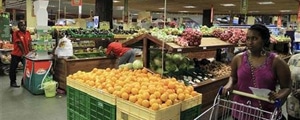
DESPITE the liquidity crunch obtaining in the market, the cost of living has been on a steady rise in recent months driven by high fuel and food prices.
Report by Victoria Mtomba
With no salary increments for most employees and a liquidity crunch, consumers have been forced to further tighten their belts. Latest statistics from the Consumer Council of Zimbabwe (CCZ) show that the cost of living for a family of six increased to $570,75 in February from $567,90 in January 2013.
The food basket increased by $2,48 to $157,91 from $155,43 in January.
During the month of February roller meal went up by 42 cents, cooking oil was up by 20 cents, tomatoes were up by 10 cents.
Onions increased by 23 cents, bath soap by 10 cents and tea leaves recorded the biggest increase of 47 cents.
“As anticipated, the price of other basic goods increased because of the increase in fuel prices,” CCZ said.
“Diesel increased from $1,32 to $1,40 per litre and petrol from $1,47 to $1,55 per litre.”
- Chamisa under fire over US$120K donation
- Mavhunga puts DeMbare into Chibuku quarterfinals
- Pension funds bet on Cabora Bassa oilfields
- Councils defy govt fire tender directive
Keep Reading
However, CCZ assistant executive director Rose Mpofu says there has not been a significant change in the spending patterns since last year.
“I must say that the prices are stable and the consumption trends have not changed,” she said. “We are still coming from January and prices are generally stable.”
The majority of the workforce — civil servants — earn below the poverty datum line meaning that many people do not have disposable income.
In January civil servants got a 5% salary adjustment. “People are buying day-to-day commodities and what is difficult is to get big loans from banks,” Mpofu said.
According to the African Development Bank monthly report for February, food items have been the main driver of both annual and month-on-month inflation.
“Policy measures targeted at increasing the supply of food and the reduction of food prices were expected to lead to lower inflation levels,” said the AfDB.
The regional lender also expressed concern at the rise in the minimum nominal lending rates for commercial and merchant banks. The rates rose from 10% and 15% per annum in December from their November 2012 levels of 6% and 13% respectively.
“The increases are unfavourable in an environment where there is need for cheaper finance to boost the productive sectors.
“Notably, beginning November 2012, upper limits on quoted lending rates for merchant banks declined from 35% to 25%,” AfDB said. “However, the lower limit on merchant bank lending increased from 13% to 15% in December 2012 while that for commercial banks increased from 6% to 10%.
“These developments imply that for commercial banks, borrowing has become more expensive for borrowers with low capacity while for merchant banks, borrowing has become more expensive for borrowers with low capacity and cheaper for borrowers with high capacity. “The prevailing pattern in lending rates is unfavorable for borrowers with limited capacity.
“It also implies that following these changes, some borrowers with low capacity have been priced out of the market.”











